Porcelain Insulator News
by Elton Gish, NIA #41
Reprinted from "Crown Jewels of the Wire", February 1991, page 16
There have been two new incuse Locke markings reported. The first one is
shown in the photograph below and is simply: "VICTOR". Note that this
marking has quotation marks before and after the word VICTOR. This marking was
found on U-670A. It has been assigned Fred Locke marking number #0-1a.
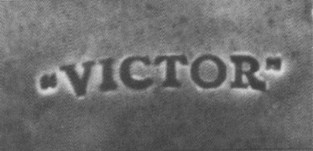
Fred Locke marking #0-1a
The second incuse Locke marking was reported by Ken Willick. Ken found this
one on a broken multipart, but not enough of it remained to determine the M-number. This marking is very similar to the one above. It is:
|
Fred Locke #0-1b |
"VICTOR"
PATENTED |
(word PATENTED is less than 1/2 size of word VICTOR) |
Again note the quotation marks around the word "VICTOR". This Fred Locke
marking has been assigned #0-1b.
Now for all of you out there who are particular about collecting and
cataloging all of the various Fred Locke patent date incuse markings, the
following reports will be for you. I know of only a couple of collectors besides
myself that fit this category, but since I am one of them, I would like to set
the record straight by making the differences official in published form. All of
the previously reported incuse Fred Locke markings can be found in Jack Tod's
third edition (1988) book, Porcelain Insulators. I personally revised all of the
Fred Locke markings for Jack's book using specimens from my collection. I have
several specimens of most of the markings, so the details of each marking should
be very accurate except for an occasional period.
Robin Harrison found a U-675
with a #4-4 Fred Locke marking. We are reporting this previously reported marking
because, until now, only one specimen was known with the #4-4 marking, and that
specimen did not have the third line of the marking. So, Robin's specimen allows
us to complete marking #4-4 as shown below. There are four type sizes. The third
line is composed of the two smaller type sizes. For simplicity, only the largest
type in each line has been underlined. Another interesting note is that Robin's
U-675 was dated Jan.15, 1901 and the specimen first reporting #4-4 (also on
U-675) was dated Jan.16, 1901.
Fred
Locke #4-4
(completed) |
PAT-NOV24 &
DEC 15 96
SEP 28-97 JUN 7-98
F M LOCKE VICTOR N Y |
(San Serif, largest on each line of 4 type sizes
underlined) |
Matt Poage has reported a new four-date Fred Locke marking as shown below.
This marking was found on M-2795 and it is very similar to marking #4-1. There
are some differences in punctuation and many of the letters and numbers are run
together without spaces between. We have assigned this new four-date marking #4-5. Another interesting note about this particular M-2795 is that it had an
unusual manufacturing date error: JNE.3.1901
Fred Locke
marking #4-5 |
PATNOV24&DEC1596
SEP.28, 97 JUNE7 '98
F.M.LOCKE VICTORN.Y. |
(San serif, largest type underlined) |
I have been tracking Fred Locke markings appearing on each insulator style.
So, Matt Poage's recent report, after he read PIN in September, 1990
"CJ" was very
interesting. Matt reported a new marking/style combination, namely, a M-2796
with marking #1-7. Neither the M-2795 nor M-2796 have been reported with this
single patent date marking. At the end of this month's PIN is a list of all
known (by me) Fred Locke markings and the insulator style on which the marking
appears. To date, I have not seen specimens with markings #0-7, #1-10 and #4-3a, so I cannot confirm on which style these markings exist.
I just received a letter from Mike Guthrie also in response to the September,
1990 PIN article. He reports a M-2795 with Fred Locke marking #6-2. The
difference in his specimen is that it has the latest manufacturing date yet
reported: 1DEC4 901.Naturally, that should read: "DEC4 1901" -- as Mike
said, "The 1 got misplaced." Mike also reports that his M-2796 with
marking #6-2 does indeed have sulfur cement. This specimen was obtained from
Hawaii. He also notes that there should be periods in marking #6-1 after
"SEPT. and DEC.".
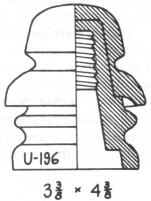
Robin Harrison has reported an important new
insulator style. It is a Fred Locke glazewelded tramp with the underglaze ink
marking #6-3. All of the insulators with the underglaze ink markings were made
by Imperial Porcelain Works for Fred Locke circa 1897-1898. This new glazeweld
tramp has been assigned U-196. This style is important in that it is the first
style of porcelain transposition ever made. This lone specimen has an early
white glaze typical of Imperial production. Below is a photograph showing
Robin's U-196.
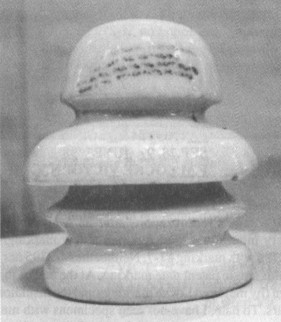
U-196 with Fred Locke marking #6-3
At the Portland National last summer, Grant Salzman showed me a "nice
old porcelain helmet" with strangely shaped ears. It had a weak Fred Locke
marking on the skirt. I was nearly speechless with anticipation that Grant would
he willing to part with his "$10" purchase. Well, the joke was
complete. This new helmet style belonged to the show host, Steve Watkins, and
the insulator, of course, was not for sale. DRAT! Now, what does a good glass
collector need with an ugly brown porcelain helmet? "It was odd
looking!", Steve admitted. It would not look so odd sitting on my shelf
next to a U-380 with #04 marking and it's other cousins from Victor, NY. This
"new", "odd" Fred Locke helmet has been assigned U-383.
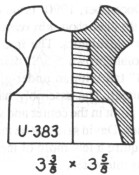
The two drawings of U-383 and U-196 are my first attempts at making ink
drawings of new insulator styles. Jack Tod has performed this seemingly easy
task several thousands of times. He made all of the drawings for the u-number
styles, both his books and Marilyn Albers' foreign porcelain hooks, as well as
all of the CD- numbers for N. R. (Woody) Woodward's 1988 hook, and for Marilyn
Albers' and "Woody's" foreign glass books. So, you can see that Jack
had plenty of practice. Please bear with me. It has been 22 years since I have
made ink drawings.
The next photograph (below) is a strain insulator with an unusual marking for
this type of insulator. It has the early Locke insulator-insignia marking with
the legend "VICTOR // R=oo". The marking dates the manufacture of this
insulator to circa 1910's. This particular marking was used from 1908 to 1922
when the word "VICTOR" inside the insulator-insignia was changed to
"LOCKE". These insulators were cataloged as the "Victor" Guy
Insulator. They were used for guying or dead-ending of power lines.
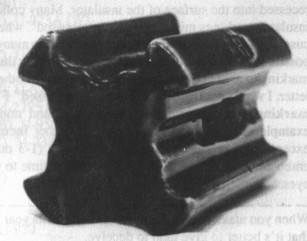
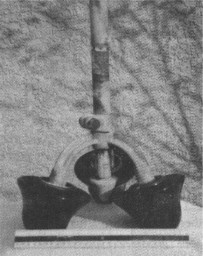
David Wilson sent this photograph (above) of a new addition to his
collection. It is one-half of an O-B "Control Gap" as shown in PIN in
the December, 1990 issue of "CJ". Note the three short skirt version
"mushroom" insulators. The insulators are chocolate brown 5-5/8"
diameter and 4-1/4" tall with an under-glaze radio treatment. The assembly
has a brass cone point in the center and weighs 20 pounds. David said that he
may be able to acquire a few more of these if anyone is interested.
I will be accused of getting on Jack Tod's soapbox on this next topic, but
most of us need a gentle reminder again. The last reminder was sometime before
1984 when Jack was writing "PIN". It is understood that some people
will never change, but we should not continue to misinform the newer collectors
of porcelain insulators. [Note that I did not say "mud",
"crockery", "pottery", or any other incorrect term to
describe high-quality electrical porcelain.] I want to remind everyone that most
markings on wet process porcelain insulators are "incuse" markings.
Except for the embossed Lapp marking (and a couple of minor ones) on wet process porcelain insulators,
only dry process porcelain insulators and
glass insulators have "embossed" [raised] markings. The markings found
on wet process porcelain insulators are either underglaze ink, sand-blast,
recess-embossed, or "incuse" markings. Incuse means that the marking
is recessed into the surface of the insulator. Many collectors referring to
porcelain insulator markings mistakenly say "embossed" when they
should be using "incuse" or any of the other marking types. With so
many different types of markings possible on porcelain insulators, it is
important that we properly describe the marking to avoid confusion by the person
on the other end of the conversation or letter. I would dearly love to have an "embossed" Fred Locke 4-date or 6-date
marking, but, unfortunately, none
exist, and none will ever be found. For example, all Fred Locke markings are
either incuse or underglaze ink with exception of one being recessed-embossed
(1-3 on pin bases) and one being embossed (2-1 on U-923C). Confused? It is time
to wash the "mud" from your eyes.
KNOWN FRED LOCKE MARKINGS
(W)--WHITE
(B)-- BROWN
| MARKING |
|
|
0-1 |
Too numerous to list |
|
0-1a |
U-670A |
|
0-1b |
Unknown multipart |
|
0-2 |
U-38 (W), U-39 (W), U-39 (B), U-259 (W), U-441 (B), U-447 (W), U-611A (W), BUSHING |
|
0-3 |
U-3 (B), U-39 (B), U-55, U-259 (W), U-259 (B) |
|
0-4 |
U-3 (B), Sim U-3 (B), U-39 (W), U-39 (B), U-259 (W),
U-380 (B), Sim U-447 (W) |
|
0-5 |
U-3 (W) |
|
0-6 |
U-3 (B), U-39 (B), U-55, U-220A/B, U-242, U-330A |
|
0-7 |
?? |
|
0-8 |
U-39 (W) |
|
1-1 |
U-608A (W), Pin Base (W) |
|
1-2 |
U-192A, Pin Base (B) |
|
1-3 |
Pin Base (W) |
|
1-4 |
U-192A, U-220A/B |
|
1-5 |
M-2795 |
|
1-6 |
U-441 (B), U-639 (W), U-639 (B) |
|
1-7 |
U-611A (W), U-611A (B), M-2796 |
|
1-8 |
U-339A, U-529A (B), U-608A (B), U-648 (W),
U-648 (B), U-670A (B), U-926A |
|
1-9 |
U-3 (B), U-608A (B), U-608A (W), U-611A (W),
U-670A (W) |
|
1-10 |
?? |
|
2-1 |
U-923C (W) |
|
2-2 |
U-923 (W), U-923A (W) |
|
3-1 |
U-923 (W), U-940 (W) |
|
4-1 |
U-675 (W), U-675 (B), U-925 (B), M-2335, M-2795,
M-2795 (W), M-2796 |
|
4-2 |
U-939C (B), U-955, M-2795 |
|
4-3 |
U-925 (W), M-2335 |
|
4-3a |
?? |
|
4-4 |
U-675 (W) |
|
4-5 |
M-2795 |
|
5-1 |
U-927A, U-939 |
|
6-1 |
U-670A (B), U-923D, U-925 (W), U-926A, M-2332,
M-2785 |
|
6-2 |
U-529A, U-699, U-925 (W), M-2795, M-2842 |
|
6-3 |
U-3 (W), U-196 (W), U-608A (W), U-925 (W),
U-927B (B), U-939D (W), U-941 (W)??, U941A (W) |
|
7-1 |
U-926A, U-964, U-964 (1-3/8" Pin Hole), M-2250, M-2430,
M-3060, M-3721, M-3725 |
|
